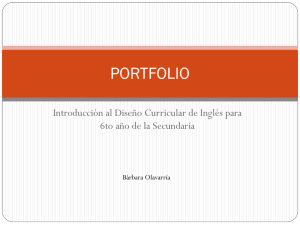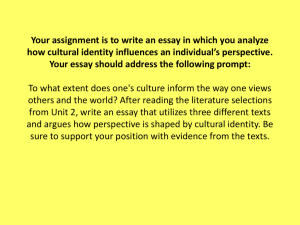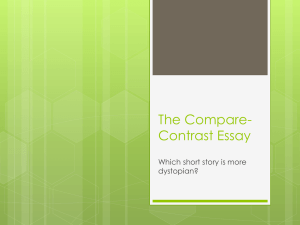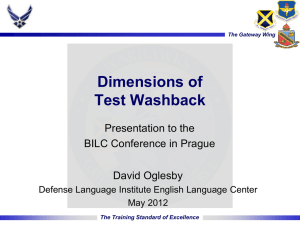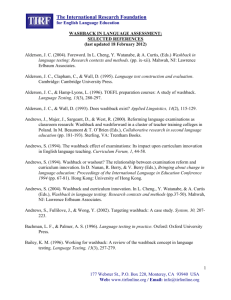Washback
advertisement
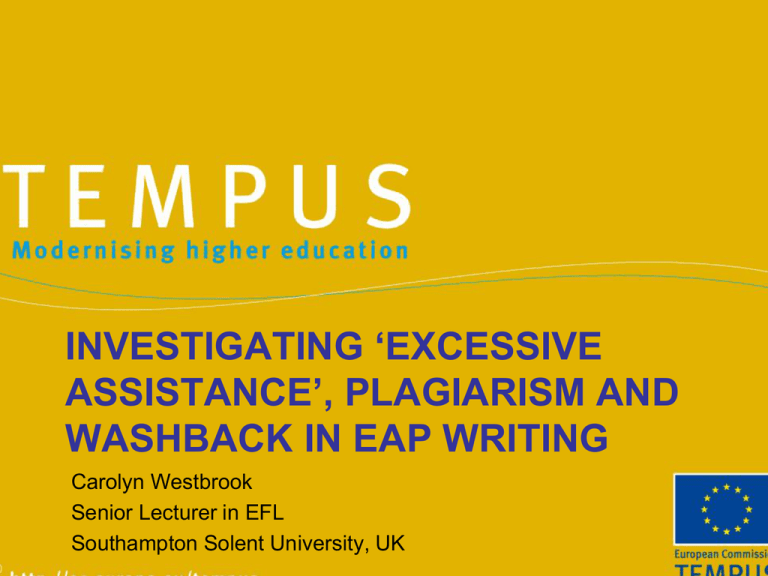
INVESTIGATING ‘EXCESSIVE ASSISTANCE’, PLAGIARISM AND WASHBACK IN EAP WRITING Carolyn Westbrook Senior Lecturer in EFL Southampton Solent University, UK Outline Introduction Key terms The importance of washback Rationale for the project The research project Summary and conclusions Introduction … or: Who am I and why am I here? ? ProSET Key terms … or: What is she talking about? What do you understand by these terms? ‘excessive assistance’ ‘plagiarism’ ‘washback’ Ahaa … that’s what she means! (1) ‘Excessive assistance’ is when a student is helped with an assessed task by a peer or family member and this help is unidentifiable and undeclared. Ahaa … that’s what she means! (2) ‘Plagiarism’ is when a student uses the words or ideas of someone else without acknowledging them in their work. ‘Washback’ is ‘the effect of testing on teaching and learning’ (Hughes, 1989: 1) The importance of washback Why do we care about washback? Importance for test validation: Socio-cognitive framework for test validation (Weir, 2005) Qualities of test usefulness (Bachman & Palmer, 1996) A socio-cognitive framework for test validation (Weir, 2005) Test-taker characteristics Context validity Theory-based validity Response Scoring validity Score / grade Consequential validity Criterion-related validity Qualities of test usefulness (Bachman & Palmer, 1996) Construct Validity Reliability Impact Practicality Authenticity Interactiveness Impact – definition Impact: The influence a test has on society and educational systems and … the individuals within those systems (Bachman & Palmer, 1996: 19-35) Who does a test impact on? Employers How do we investigate washback? ‘… test developers … must actually investigate the specific areas (such as content of teaching, teaching methodology, ways of assessing achievement), direction (positive, negative), and extent of the presumed impact.’ (Wall and Alderson, 1993, in Bachman & Palmer, 1996: 30-31) The problem of ‘excessive assistance’ ‘Excessive assistance’ manifests itself as: ‘help’ from friends use of Google Translate to translate books or texts for an assignment Problem: Turnitin does not detect Google Translate (or books, unless they have previously been entered in to the database Why do students plagiarise? Intentional ‘Strategic approach to higher education, wanting … a degree while needing employment’ (Moon, 1999) ‘Weaker’ students want to ‘avoid failure’ (Wilhoit, 1994, in Underwood and Szabo, 2004:181) Unintentional Lack of understanding (Bamford and Sergiou, 2005) Lack of time to include references (Gillett, 2011) Previous writing task - example The same student’s in-class test The People imProvements the health in This life and they helPing together If the government looking to the new life for this help. The health in this life it’ss important for etch one to get the PeoPle save in the life, i shoud take health and tell any one hwo is did’nt do teh health for this life. In my oPinion i shoud tell for the governments of richer nations if they helping Poorer nations in such areas that i thik dis agree with this think. If governments looking for the help to PeoPle i agree with the Pest think and the PeoPle do good think for governments I would like but every one in hes work as he get or he have abuot the scalar sheP from when he had befor However the PeoPle help government in the life of health. Previous assessed writing tasks Process essay done outside of class with feedback tutorials Based on undergraduate study field Length 400-900 words (Sabanci); 1500 words (Solent) Paraphrasing and in-text citations requisites of the task Process essay: positive washback Students researched the topic to find relevant information Some students successfully managed to paraphrase and use correct in-text citation Those who attended tutorials got feedback on essay Process essay: negative washback In particular, students: were reluctant to read texts carefully did not develop appropriate paraphrasing or intext citation skills did not develop necessary linguistic skills (esp. competence in key vocabulary and lexicogrammatical structures) Inability to perform the task despite perception that they were doing it High failure / Academic Misconduct rate Our project – the context Sabanci University English-medium university Foundation Development Year – 250-300 students Variety of course-based and exambased assessments Exit level: approx. B2 Our project – the context Southampton Solent University British university International Foundation Year – 60-100 students Variety of course-based and exam-based assessments Exit level: approx. B2 The Open Book Exam 4 practice texts (approx. 20 pages) and text activity pack as well as a practice essay task (not assessed) on a different topic to that of the exam 4 new texts (approx. 20 pages) 4 weeks before the exam and text activity pack – worked on in and outside of class Evaluation of the Open Book Exam Washback on learning - 1 Lecturers: changed the teaching from mainly tutorial classes to a mixture of working on the text packs and giving feedback on the practice essay worked in more depth on reading skills gave feedback on practice essays but no marks Washback on learning - 2 Time spent on practice texts and exam texts 40% 35% n=54 30% 25% 20% Practice texts 15% Exam text pack 10% 5% 0% Less than 2 hours 2-6 hours 8-12 hours 12-16 hours Over 16 hours Washback on learning - 3 Test preparation What did you do to prepare for the test? n=37 21% General writing practice - grammar, linking words, essay writing, etc. Further reading/research 49% 30% Further interaction with the text pack Washback on learning - 4 Predicting the essay question How well did you predict the question? n=52 13% 25% 14% 48% Very well - I predicted the question almost exactly Quite well - I had predicted some parts of the question Not very well at all - I didn't predict any parts of the question I didn't try to predict the question Washback on learning - 5 It’s not all positive … Negative washback: Students do not need to practise research skills as all texts are provided Open Book Exam and preparation encourage careful reading but not expeditious reading Reducing excessive assistance Preparation – may have had help before the exam - handwriting check: Sabanci: 94/100 matched Solent: 53/54 matched (but 11: no/very few notes) Exam room – no chance of excessive assistance Reducing plagiarism - 1 Practice essay: 113 submissions (49 students) Mean Similarity Index: 33% Reducing plagiarism - 2 Exam: 54 students Mean Similarity Index: 9.6% Practice essay and exam: both plagiarism and correct referencing evidence of learning about plagiarism Summary Positive AND negative washback on learning: learning about plagiarism; increased engagement with texts → extended reading; decrease in plagiarism between practice essay and exam; decrease in excessive assistance / predicting essay question; ss do not practice research skills; careful reading but not expeditious reading; The moral of the story is … … don’t assume that all changes will always be for the better. Questions or comments? Carolyn.westbrook@solent.ac.uk
